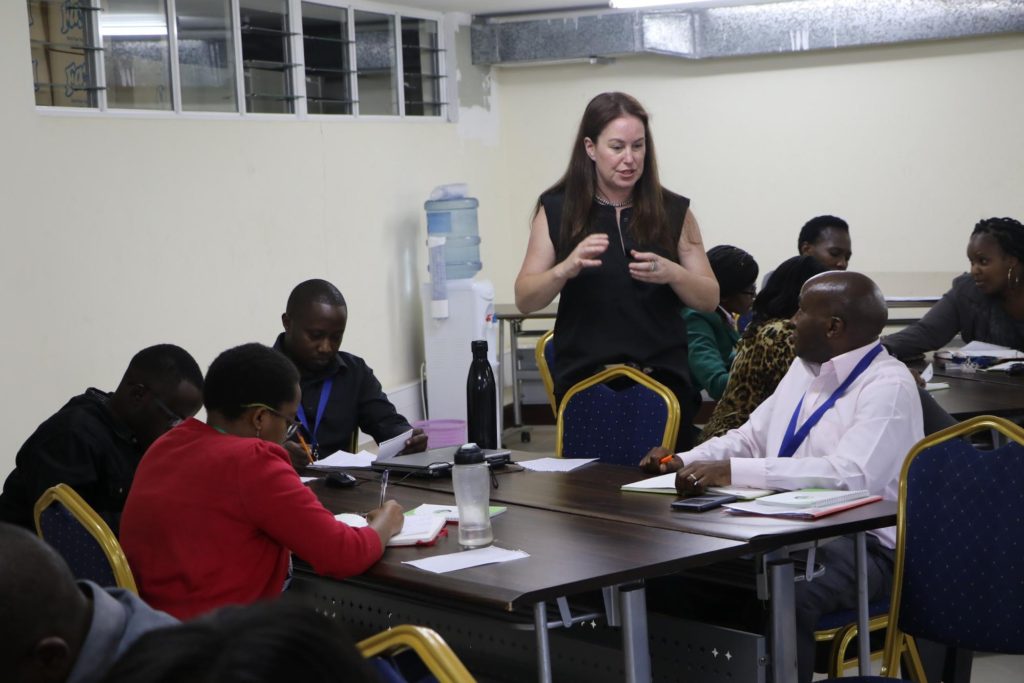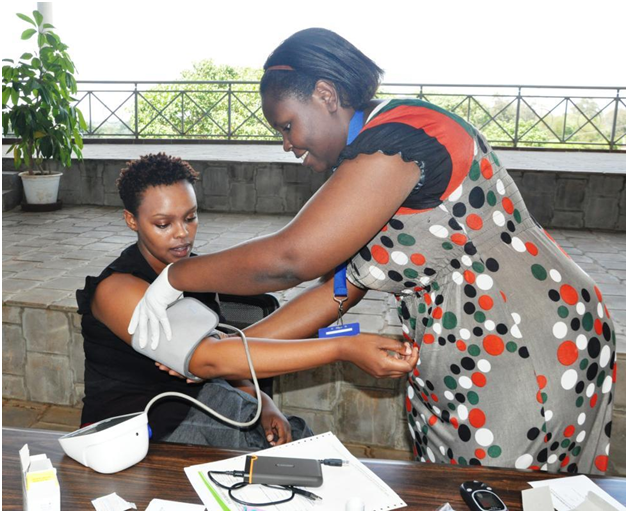Poor breastfeeding practices are widely documented in Kenya, where only a third of children are exclusively breastfed for 6 months and only 2% in urban poor settings.This study aimed to better understand the factors that contribute to poor breastfeeding practices in two urban slums in Nairobi, Kenya. […]
Read More…
Rapid urbanisation in Kenya has resulted in growth of slums in urban centres, characterised by poverty, inadequate social services and poor health outcomes. The government’s initiatives to improve access to quality healthcare for mothers and children are largely limited to public health facilities, which are few and/or inaccessible in under-served areas such as the slums.
The ‘Partnership for Maternal, Newborn and Child Health’ (PAMANECH) project is being implemented in two Nairobi slums, Viwandani and Korogocho, to assess the impact of strengthening public–private partnerships for the delivery of healthcare on the health of mothers, newborns and young children in two informal settlements in Kenya. […]
Read More…
Background
Many low- and middle-income countries are undergoing a nutrition transition associated with rapid social and economic transitions. We explore the coexistence of over and under nutrition at the neighborhood and household level, in an urban poor setting in Nairobi, Kenya.
Methods
Data were collected in 2010 on a cohort of children aged under five years born between 2006 and 2010. Anthropometric measurements of the children and their mothers were taken. Additionally, dietary intake, physical activity, and anthropometric measurements were collected from a stratified random sample of adults aged 18 years and older through a separate cross-sectional study conducted between 2008 and 2009 in the same setting. Proportions of stunting, underweight, wasting and overweight/obesity were determined in children, while proportions of underweight and overweight/obesity were determined in adults.
Results
Of the 3335 children included in the analyses with a total of 6750 visits, 46% (51% boys, 40% girls) were stunted, 11% (13% boys, 9% girls) were underweight, 2.5% (3% boys, 2% girls) were wasted, while 9% of boys and girls were overweight/obese respectively. Among their mothers, 7.5% were underweight while 32% were overweight/obese. A large proportion (43% and 37%%) of overweight and obese mothers respectively had stunted children. Among the 5190 adults included in the analyses, 9% (6% female, 11% male) were underweight, and 22% (35% female, 13% male) were overweight/obese.
Conclusion
The findings confirm an existing double burden of malnutrition in this setting, characterized by a high prevalence of under nutrition particularly stunting early in life, with high levels of overweight/obesity in adulthood, particularly among women. In the context of a rapid increase in urban population, particularly in urban poor settings, this calls for urgent action. Multi-sectoral action may work best given the complex nature of prevailing circumstances in urban poor settings. Further research is needed to understand the pathways to this coexistence, and to test feasibility and effectiveness of context-specific interventions to curb associated health risks. […]
Read More…

The African Population and Health Research Center (APHRC) officially handed over the second ambulance to the Makadara Sub-County on the […]
Read More…

By Gregory Warner Some blame witchcraft. Others think it’s a bad batch of moonshine. But Esther Okaya, who lives in Korogocho, […]
Read More…
The Guardian Global Development Professional Network hosted an online debate on the 28th August 2014 from 3pm – 6pm […]
Read More…

The Joint Advanced Seminar 3 (JAS-3) for Cohort 2 of the Consortium for Advanced Research Training in Africa (CARTA) fellows […]
Read More…

When one thinks of malnutrition in Kenya or any other African country, what usually comes to mind is stunting, underweight, […]
Read More…
Over 200 people from Korogocho gathered at the Chief’s Camp on Tuesday the 24th of June to witness the launch […]
Read More…

The African Population and Health Research Center (APHRC) in conjunction with the Nairobi County Government handed over two neo-natal resuscitation […]
Read More…

The 17th of May was World Hypertension Day and at APHRC, we organized a free screening by trained community health […]
Read More…
Frederick Wekesah, Research Officer, APHRC The WHO refers to mental health as “A state of complete physical, mental and social […]
Read More…

APHRC, the lead partner in a consortium that is implementing a community-based family planning (FP) initiative in Siaya and Busia […]
Read More…
The burden of cardiovascular disease is rising in sub-Saharan Africa with hypertension being the main risk factor. However, context-specific evidence on effective interventions for primary prevention of cardiovascular diseases in resource-poor settings is limited. This study aims to evaluate the feasibility and cost-effectiveness of one such intervention—the “Sustainable model for cardiovascular health by adjusting lifestyle and treatment with economic perspective in settings of urban poverty”. […]
Read More…
By Estelle Monique Sidze, Associate Research Scientist, APHRC Seeing 100 community health workers (CHWs) in action at their monthly meeting […]
Read More…
By Estelle Monique Sidze, Associate Research Scientist and Cheikh Mbackè Faye, Senior Research Officer, APHRC Located in the West Africa’s […]
Read More…
In Kenya, girls in grades 4-8, who have reached puberty, miss on average 6 learning weeks/year due to menses (i.e. […]
Read More…

The WHO refers to mental health as “A state of complete physical, mental and social well-being, and not merely the […]
Read More…
By Caroline Kabiru, Head of Urbanization and Wellbeing Program and Jessica Brinton, Working Group Program Coordinator, APHRC “Young people are […]
Read More…
Introduction:
In Kenya, the maternal mortality rate had ranged from 328 to 501 deaths per 100,000 live births over the last three decades. To reduce these rates, the government launched in 2006 a means-tested reproductive health output-based approach (OBA) voucher program that covers costs of antenatal care, a facility-based delivery (FBD) and a postnatal visit in prequalified healthcare facilities. This paper investigated whether women who bought the voucher for their index child and had a FBD were more likely to deliver a subsequent child in a facility compared to those who did not buy vouchers.
Methods and Findings:
We used population-based cohort data from two Nairobi slums where the voucher program was piloted. We selected mothers of at least two children born between 2006 and 2012 and divided the mothers into two groups: Index-OBA mothers bought the voucher for the index child (N=352), and non-OBA mothers did not buy the voucher during the study period (N=514). The most complete model indicated that the adjusted odds-ratio of FBD of subsequent child when the index child was born in a facility was 3.89 (p<0.05) and 4.73 (p<0.01) in Group 2.
Discussion and Conclusion:
The study indicated that the voucher program improved poor women access to FBD. Furthermore, the FBD of an index child appeared to have a persistent effect, as a subsequent child of the same mother was more likely to be born in a facility as well. While women who purchased the voucher have higher odds of delivering their subsequent child in a facility, those odds were smaller than those of the women who did not buy the voucher. However, women who did not buy the voucher were less likely to deliver in a good healthcare facility, negating their possible benefit of facility-based deliveries. Pathways to improve access to FBD to all near poor women are needed. […]
Read More…
Nutrition in the first 1,000 days of life (during pregnancy and the first two years) is critical for child growth and survival. Poor maternal, infant and young child nutrition (MIYCN) practices are widely documented in Kenya, with potential detrimental effects on child growth and survival. This is particularly a problem in slums, where most urban residents live. For example, exclusive breastfeeding for the first six months is only about two per cent. Innovative strategies to reach slum residents are therefore needed. Strategies like the Baby Friendly Hospital Initiative have proven effective in some settings but their effectiveness in resource-limited settings, including slums where many women do not deliver in hospital, is questionable. We propose to test the effectiveness of a home-based intervention on infant feeding practices, nutrition and health outcomes of infants born in two slums in Nairobi, Kenya. […]
Read More…
Air pollution is among the leading global risks for mortality and responsible for increasing risk for chronic diseases. Community perceptions on exposure are critical in determining people’s response and acceptance of related policies. Therefore, understanding people’ perception is critical in informing the design of appropriate intervention measures. The aim of this paper was to establish levels and associations between perceived pollution and health risk perception among slum residents. A cross-sectional study of 5,317 individuals aged 35+ years was conducted in two slums of Nairobi. Association of perceived score and individual characteristics was assessed using linear regression. Spatial variation in the perceived levels was determined through hot spot analysis using ArcGIS. The average perceived air pollution level was higher among residents in Viwandani compared to those in Korogocho. Perceived air pollution level was positively associated with perceived health risks. The majority of respondents were exposed to air pollution in their place of work with 66% exposed to at least two sources of air pollution. Less than 20% of the respondents in both areas mentioned sources related to indoor pollution. The perceived air pollution level and related health risks in the study community were low among the residents indicating the need for promoting awareness on air pollution sources and related health risks. […]
Read More…
The increase in cardiovascular diseases in sub-Saharan Africa has been attributed in part to the changes in lifestyle, and the prevalence of risk factors for cardiovascular disease is higher among urban populations than among non-urban populations. The objective of this study was to determine the prevalence of overweight and obesity and examine perceptions of body size differentiated by sex and other determinants among slum dwellers in Nairobi, Kenya. […]
Read More…
In 2008, the global urban population surpassed the rural population and by 2050 more than 6 billion will believing in urban centres. A growing body of research has reported on poor health outcomes among the urban poor but not much is known about HIV prevalence among this group. A survey of nearly 3000 men and women was conducted in two Nairobi slums in Kenya between 2006 and 2007, where respondents were tested for HIV status. […]
Read More…